Optimal Scheduling Strategy for Multi-Energy Microgrid Considering Integrated Demand Response
Abstract
1. Introduction
2. Integrated Energy System
3. Integrated Energy Demand Response Model
3.1. Time-Shifted Electricity Load Response
3.2. Reduction Electricity Load Response
3.3. Thermal Load Response
3.4. IDR Compensation Mechanism
4. Multi-Energy Complementary Combined Heating and Power (CHP)-Based Optimal Operation Model
4.1. Objective Function
- Electricity purchase cost
- 2.
- Microturbines and fuel cell gas cost
- 3.
- Maintenance and equipment loss cost
- 4.
- Heat sales revenue
4.2. Constraints
- Micro gas turbine model
- 2.
- Electric heating model
- 3.
- Power and thermal energy storage model
- 4.
- Exchange power constraint
- 5.
- Electrical and thermal power balance
4.3. Solving Algorithms
5. Simulation Analysis
5.1. Experimental Settings
5.2. Scheme 1 Results
5.3. Scheme 2 Results
5.4. Scheme 3 Results
5.5. Similarity of Three Schemes
5.6. Comparison of Three Schemes
5.7. Quantitative Comparison of Scheme 2 and Scheme 3
6. Conclusions
- Without thermal energy storage equipment and electric and thermal coupling, the system operates inefficiently and the power generation is affected by the heat generation efficiency constraint.
- Configuring thermal energy storage equipment decouples electric and thermal co-generation to a certain extent. The electric energy storage and thermal energy storage can realize the free power generation of different power generation units and the free heat generation of different heat generation units, respectively.
- The objective of this paper was to quantify and analyze the economics of a good integrated energy demand response. Through the results, it was found that via integrated energy control, all cost indicators were reduced, and the grid achieved a transformation from loss to profit; the reduction in each cost is also an indication of the reduction in equipment losses and the improvement in synergistic operation.
Funding
Data Availability Statement
Acknowledgments
Conflicts of Interest
References
- Li, Z.; Xu, Y.; Fang, S.; Zheng, X.; Feng, X. Robust Coordination of a Hybrid AC/DC Multi-Energy Ship Microgrid with Flexible Voyage and Thermal Loads. IEEE Trans. Smart Grid 2020, 11, 2782–2793. [Google Scholar] [CrossRef]
- Li, Z.; Wu, L.; Xu, Y.; Zheng, X. Stochastic-Weighted Robust Optimization Based Bilayer Operation of a Multi-Energy Building Microgrid Considering Practical Thermal Loads and Battery Degradation. IEEE Trans. Sustain. Energy 2022, 13, 668–682. [Google Scholar] [CrossRef]
- Mansouri, S.A.; Ahmarinejad, A.; Nematbakhsh, E.; Javadi, M.S.; Jordehi, A.R.; Catalao, J.P.S. Energy Hub Design in the Presence of P2G System Considering the Variable Efficiencies of Gas-Fired Converters. In Proceedings of the 2021 International Conference on Smart Energy Systems and Technologies (SEST), Virtual Conference, 6–8 September 2021; IEEE: Piscataway, NJ, USA, 2021; pp. 1–6. [Google Scholar]
- Nasir, M.; Jordehi, A.R.; Tostado-Véliz, M.; Tabar, V.S.; Amir Mansouri, S.; Jurado, F. Operation of energy hubs with storage systems, solar, wind and biomass units connected to demand response aggregators. Sustain. Cities Soc. 2022, 83, 103974. [Google Scholar] [CrossRef]
- Wang, S.; Wang, S.; Zhao, Q.; Dong, S.; Li, H. Optimal dispatch of integrated energy station considering carbon capture and hydrogen demand. Energy 2023, 269, 126981. [Google Scholar] [CrossRef]
- Karimi, H.; Jadid, S. Multi-layer energy management of smart integrated-energy microgrid systems considering generation and demand-side flexibility. Appl. Energy 2023, 339, 120984. [Google Scholar] [CrossRef]
- Javadi, M.S.; Gough, M.; Mansouri, S.A.; Ahmarinejad, A.; Nematbakhsh, E.; Santos, S.F.; Catalão, J.P.S. A two-stage joint operation and planning model for sizing and siting of electrical energy storage devices considering demand response programs. Int. J. Electr. Power Energy Syst. 2022, 138, 107912. [Google Scholar] [CrossRef]
- Mansouri, S.A.; Ahmarinejad, A.; Ansarian, M.; Javadi, M.S.; Catalao, J.P.S. Stochastic planning and operation of energy hubs considering demand response programs using Benders decomposition approach. Int. J. Electr. Power Energy Syst. 2020, 120, 106030. [Google Scholar] [CrossRef]
- Mansouri, S.A.; Ahmarinejad, A.; Javadi, M.S.; Catalão, J.P.S. Two-stage stochastic framework for energy hubs planning considering demand response programs. Energy 2020, 206, 118124. [Google Scholar] [CrossRef]
- Sharma, S.; Verma, A.; Xu, Y.; Panigrahi, B.K. Robustly Coordinated Bi-Level Energy Management of a Multi-Energy Building Under Multiple Uncertainties. IEEE Trans. Sustain. Energy 2021, 12, 3–13. [Google Scholar] [CrossRef]
- Khatami, R.; Oikonomou, K.; Parvania, M. Look-Ahead Optimal Participation of Compressed Air Energy Storage in Day-Ahead and Real-Time Markets. IEEE Trans. Sustain. Energy 2020, 11, 682–692. [Google Scholar] [CrossRef]
- Habibi, M.; Vahidinasab, V.; Mohammadi-Ivatloo, B.; Aghaei, J.; Taylor, P. Exploring Potential Gains of Mobile Sector-Coupling Energy Systems in Heavily Constrained Networks. IEEE Trans. Sustain. Energy 2022, 13, 2092–2105. [Google Scholar] [CrossRef]
- Mansouri, S.A.; Nematbakhsh, E.; Ahmarinejad, A.; Jordehi, A.R.; Javadi, M.S.; Matin, S.A.A. A Multi-objective dynamic framework for design of energy hub by considering energy storage system, power-to-gas technology and integrated demand response program. J. Energy Storage 2022, 50, 104206. [Google Scholar] [CrossRef]
- Yang, J.; Xu, W.; Ma, K.; Li, C. A Three-Stage Multi-Energy Trading Strategy Based on P2P Trading Mode. IEEE Trans. Sustain. Energy 2023, 14, 233–241. [Google Scholar] [CrossRef]
- Shariat Torbaghan, S.; Madani, M.; Sels, P.; Virag, A.; Le Cadre, H.; Kessels, K.; Mou, Y. Designing day-ahead multi-carrier markets for flexibility: Models and clearing algorithms. Appl. Energy 2021, 285, 116390. [Google Scholar] [CrossRef]
- Zhang, K.; Zhou, B.; Or, S.W.; Li, C.; Chung, C.Y.; Voropai, N. Optimal Coordinated Control of Multi-Renewable-to-Hydrogen Production System for Hydrogen Fueling Stations. IEEE Trans. Ind. Appl. 2022, 58, 2728–2739. [Google Scholar] [CrossRef]
- Wang, X.; Huang, W.; Wei, W.; Tai, N.; Li, R.; Huang, Y. Day-Ahead Optimal Economic Dispatching of Integrated Port Energy Systems Considering Hydrogen. IEEE Trans. Ind. Appl. 2022, 58, 2619–2629. [Google Scholar] [CrossRef]
- Zhang, J.; Sun, K.; Li, C.; Liu, H.; Huang, W.; Zhou, B.; Hou, X. Economic Scheduling of Gaseous-liquid Hydrogen Generation and Storage Plants Considering Complementarity of Multiple Products. J. Mod. Power Syst. Clean Energy 2023, 11, 223–233. [Google Scholar] [CrossRef]
- Jamali, A.; Aghaei, J.; Esmaili, M.; Nikoobakht, A.; Niknam, T.; Shafie-khah, M.; Catalao, J.P.S. Self-Scheduling Approach to Coordinating Wind Power Producers with Energy Storage and Demand Response. IEEE Trans. Sustain. Energy 2020, 11, 1210–1219. [Google Scholar] [CrossRef]
- Bitaraf, H.; Rahman, S. Reducing Curtailed Wind Energy through Energy Storage and Demand Response. IEEE Trans. Sustain. Energy 2018, 9, 228–236. [Google Scholar] [CrossRef]
- Mansouri, S.A.; Ahmarinejad, A.; Sheidaei, F.; Javadi, M.S.; Rezaee Jordehi, A.; Esmaeel Nezhad, A.; Catalão, J.P.S. A multi-stage joint planning and operation model for energy hubs considering integrated demand response programs. Int. J. Electr. Power Energy Syst. 2022, 140, 108103. [Google Scholar] [CrossRef]
- Zheng, S.; Sun, Y.; Li, B.; Qi, B.; Shi, K.; Li, Y.; Tu, X. Incentive-Based Integrated Demand Response for Multiple Energy Carriers Considering Behavioral Coupling Effect of Consumers. IEEE Trans. Smart Grid 2020, 11, 3231–3245. [Google Scholar] [CrossRef]
- Honarmand, H.A.; Ghaderi Shamim, A.; Meyar-Naimi, H. A robust optimization framework for energy hub operation considering different time resolutions: A real case study. Sustain. Energy Grids Netw. 2021, 28, 100526. [Google Scholar] [CrossRef]
- Honarmand, H.A.; Rashid, S.M. A sustainable framework for long-term planning of the smart energy hub in the presence of renewable energy sources, energy storage systems and demand response program. J. Energy Storage 2022, 52, 105009. [Google Scholar] [CrossRef]
- Manshadi, S.D.; Khodayar, M.E. Coordinated Operation of Electricity and Natural Gas Systems: A Convex Relaxation Approach. IEEE Trans. Smart Grid 2019, 10, 3342–3354. [Google Scholar] [CrossRef]
- Belderbos, A.; Valkaert, T.; Bruninx, K.; Delarue, E.; D’haeseleer, W. Facilitating renewables and power-to-gas via integrated electrical power-gas system scheduling. Appl. Energy 2020, 275, 115082. [Google Scholar] [CrossRef]
- Lasemi, M.A.; Arabkoohsar, A.; Hajizadeh, A.; Mohammadi-Ivatloo, B. A comprehensive review on optimization challenges of smart energy hubs under uncertainty factors. Renew. Sustain. Energy Rev. 2022, 160, 112320. [Google Scholar] [CrossRef]
- Li, Z.; Wu, L.; Xu, Y.; Wang, L.; Yang, N. Distributed tri-layer risk-averse stochastic game approach for energy trading among multi-energy microgrids. Appl. Energy 2023, 331, 120282. [Google Scholar] [CrossRef]
- Li, Z.; Xu, Y.; Wang, P.; Xiao, G. Coordinated preparation and recovery of a post-disaster Multi-energy distribution system considering thermal inertia and diverse uncertainties. Appl. Energy 2023, 336, 120736. [Google Scholar] [CrossRef]
- Yao, W.; Wang, C.; Yang, M.; Wang, K.; Dong, X.; Zhang, Z. A tri-layer decision-making framework for IES considering the interaction of integrated demand response and multi-energy market clearing. Appl. Energy 2023, 342, 121196. [Google Scholar] [CrossRef]
- Li, K.; Ye, N.; Li, S.; Wang, H.; Zhang, C. Distributed collaborative operation strategies in multi-agent integrated energy system considering integrated demand response based on game theory. Energy 2023, 273, 127137. [Google Scholar] [CrossRef]
- Shan, C.; Zhaobin, W.; Tianli, H.; Chang, H.E.; Mengyu, Z. Multi-energy complementation based optimal operation of a microgrid with combined heat and power. Power Syst. Prot. Control 2020, 48, 160–168. [Google Scholar]
- Li, Z.; Zhang, F.; Liang, J.; Yun, Z.; Zhang, J. Optimization on Microgrid with Combined Heat and Power System. Proc. CSEE 2015, 35, 3569–3576. [Google Scholar]
- Sperstad, I.; Korpås, M. Energy Storage Scheduling in Distribution Systems Considering Wind and Photovoltaic Generation Uncertainties. Energies 2019, 12, 1231. [Google Scholar] [CrossRef]
- Carli, R.; Cavone, G.; Pippia, T.; De Schutter, B.; Dotoli, M. Robust Optimal Control for Demand Side Management of Multi-Carrier Microgrids. IEEE Trans. Autom. Sci. Eng. 2022, 19, 1338–1351. [Google Scholar] [CrossRef]
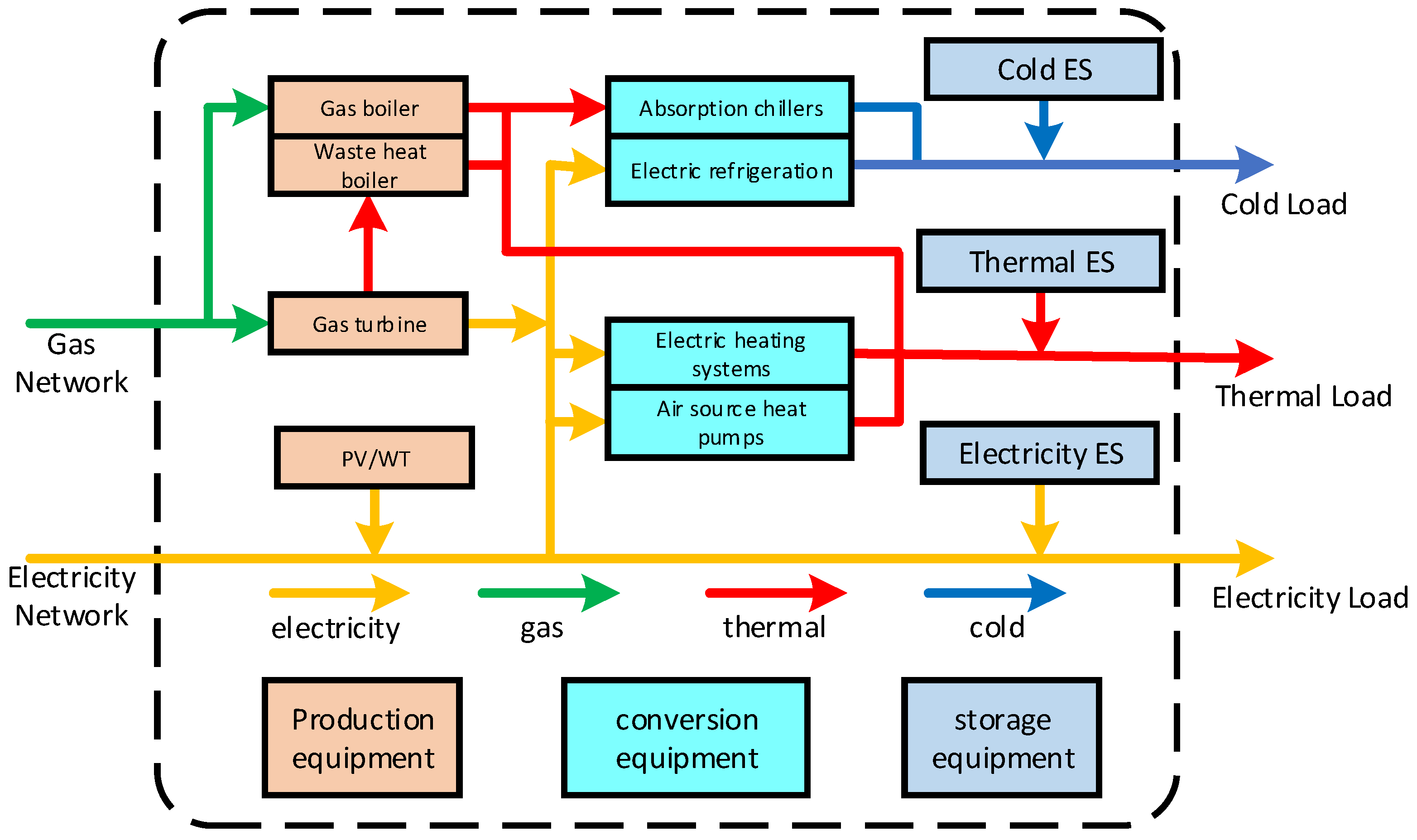
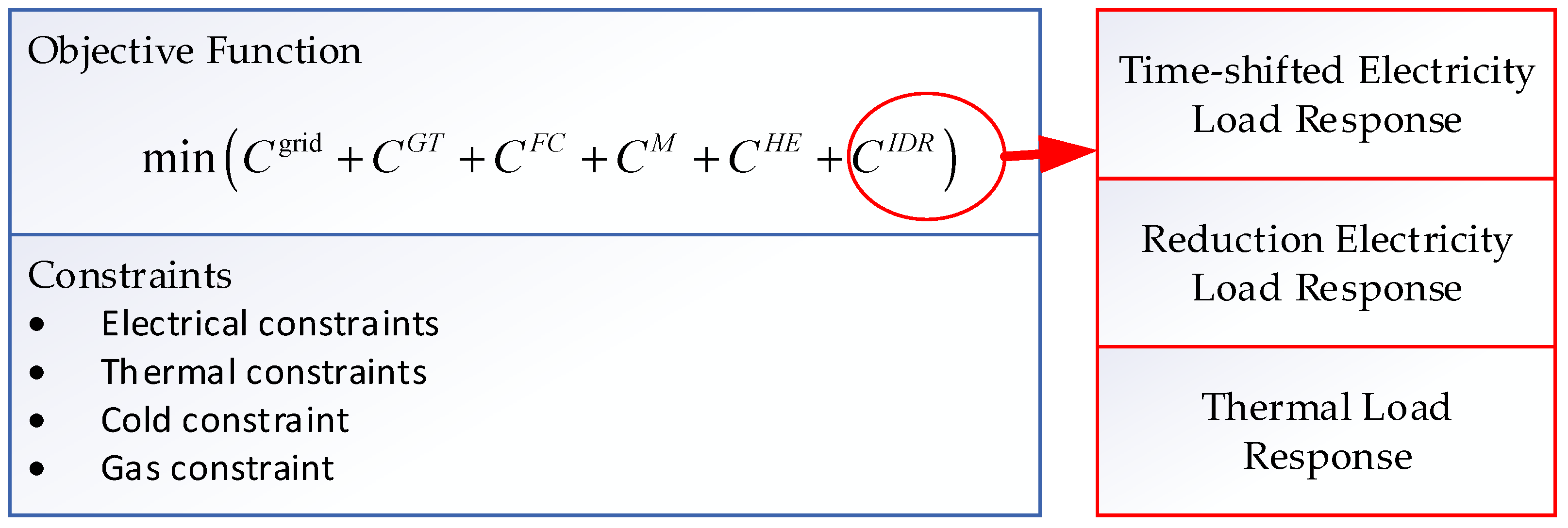
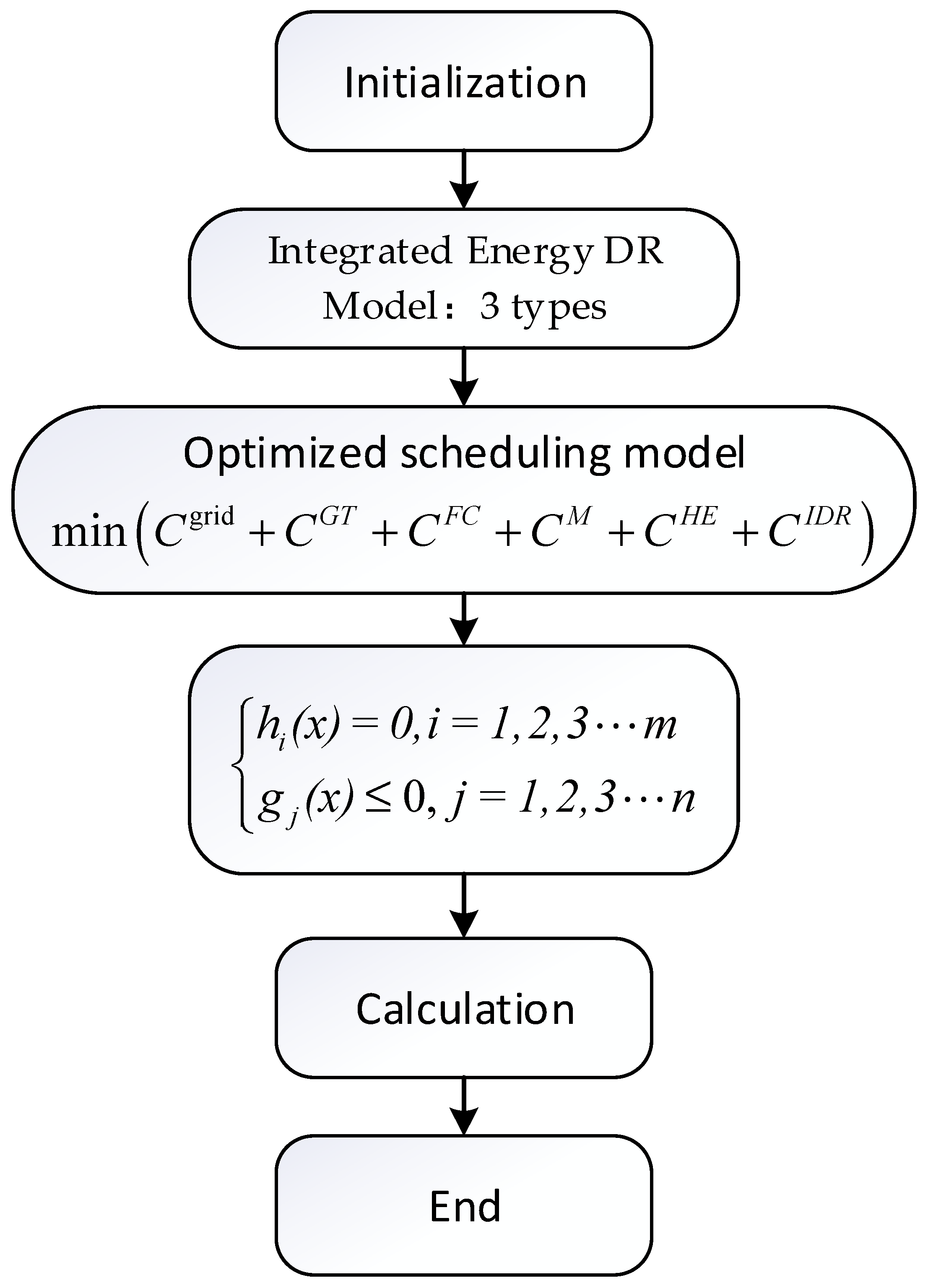
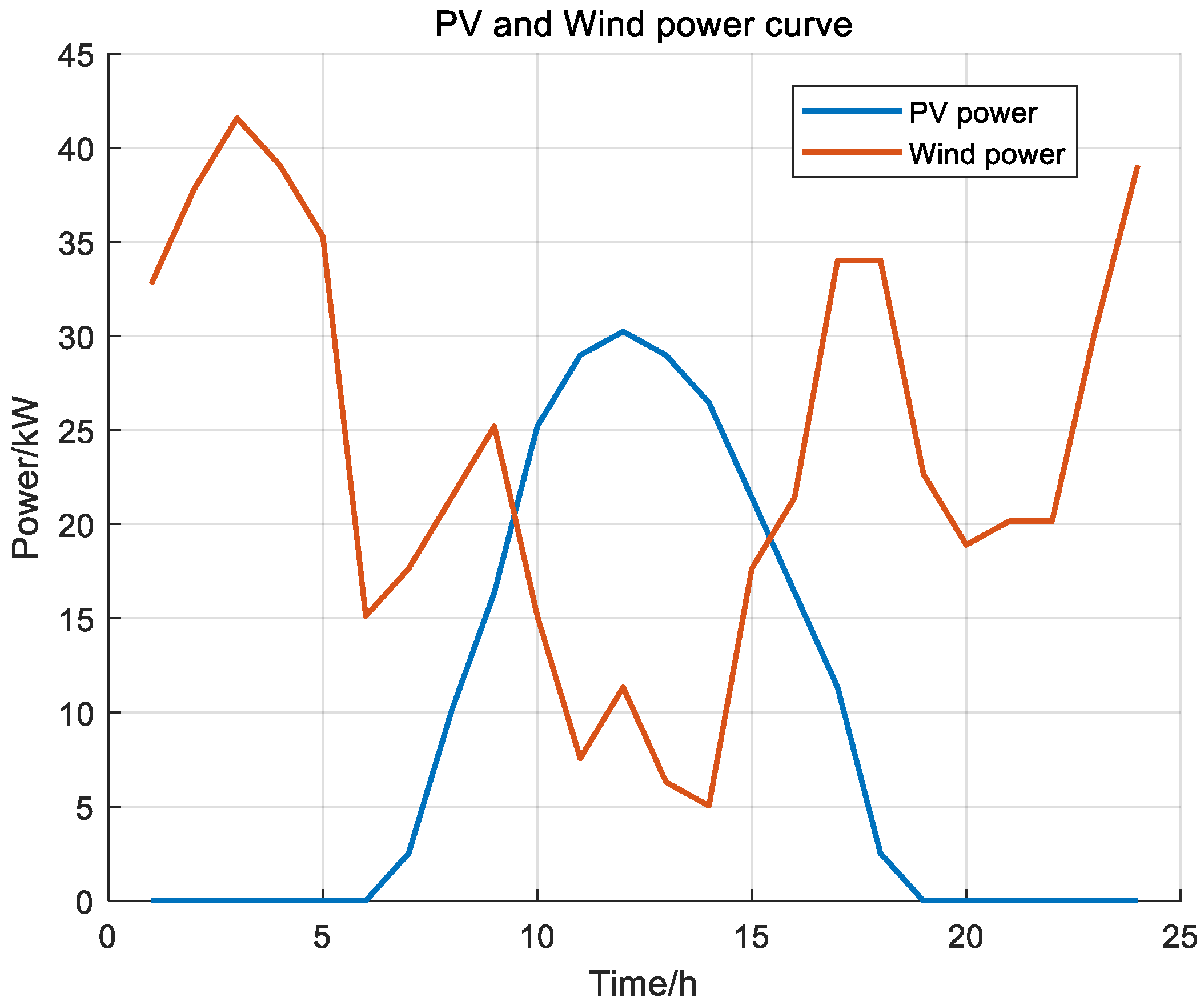
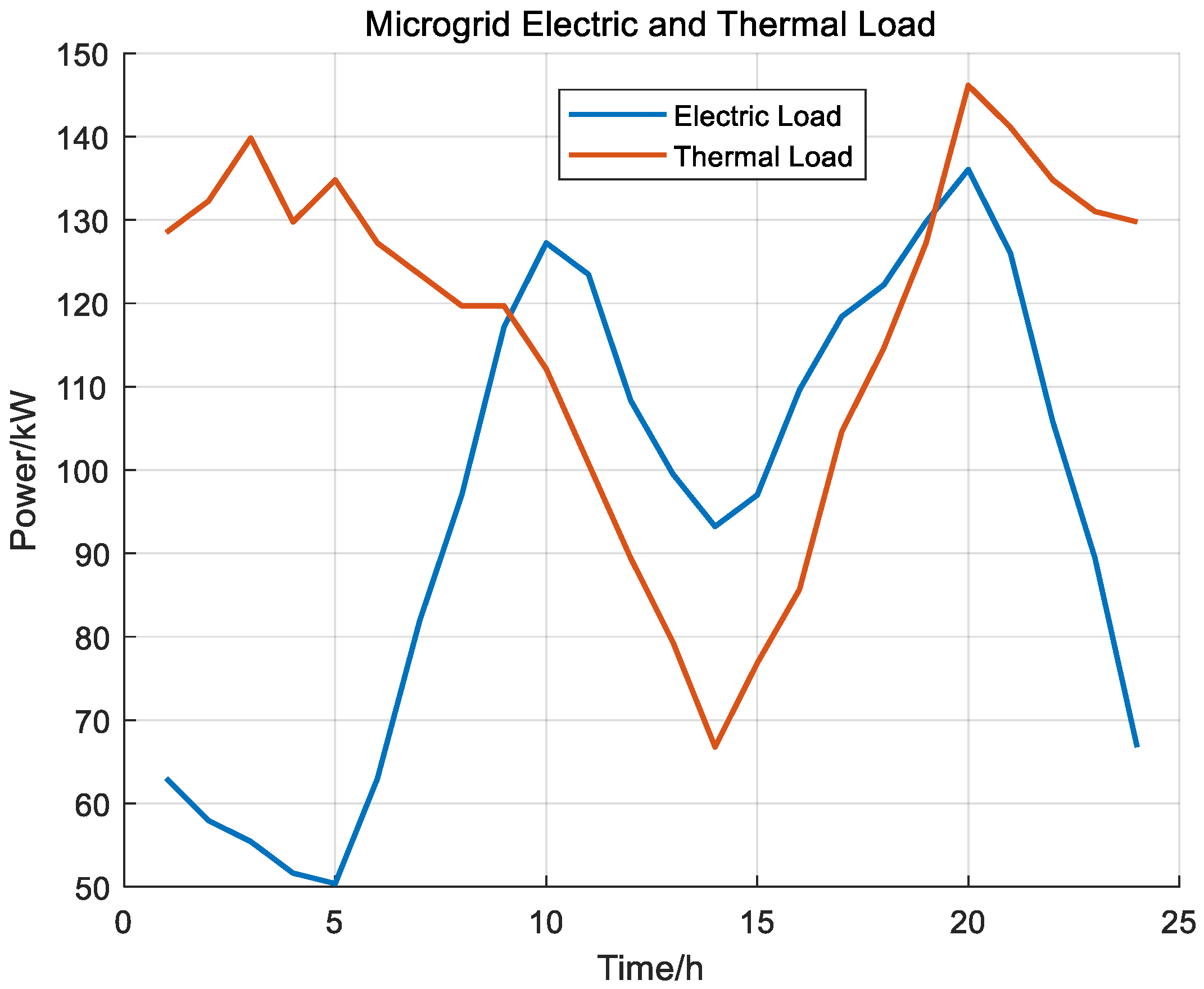
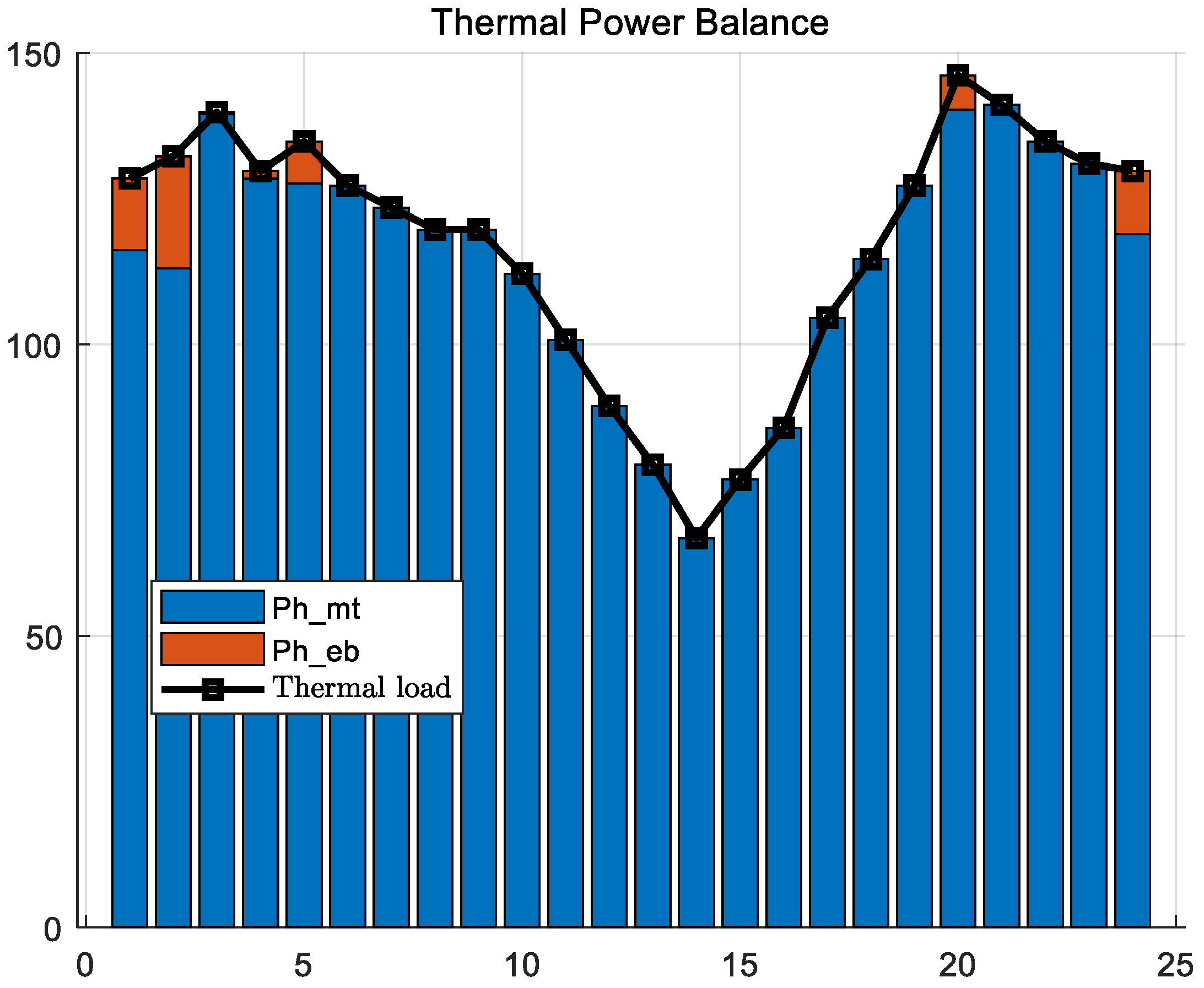
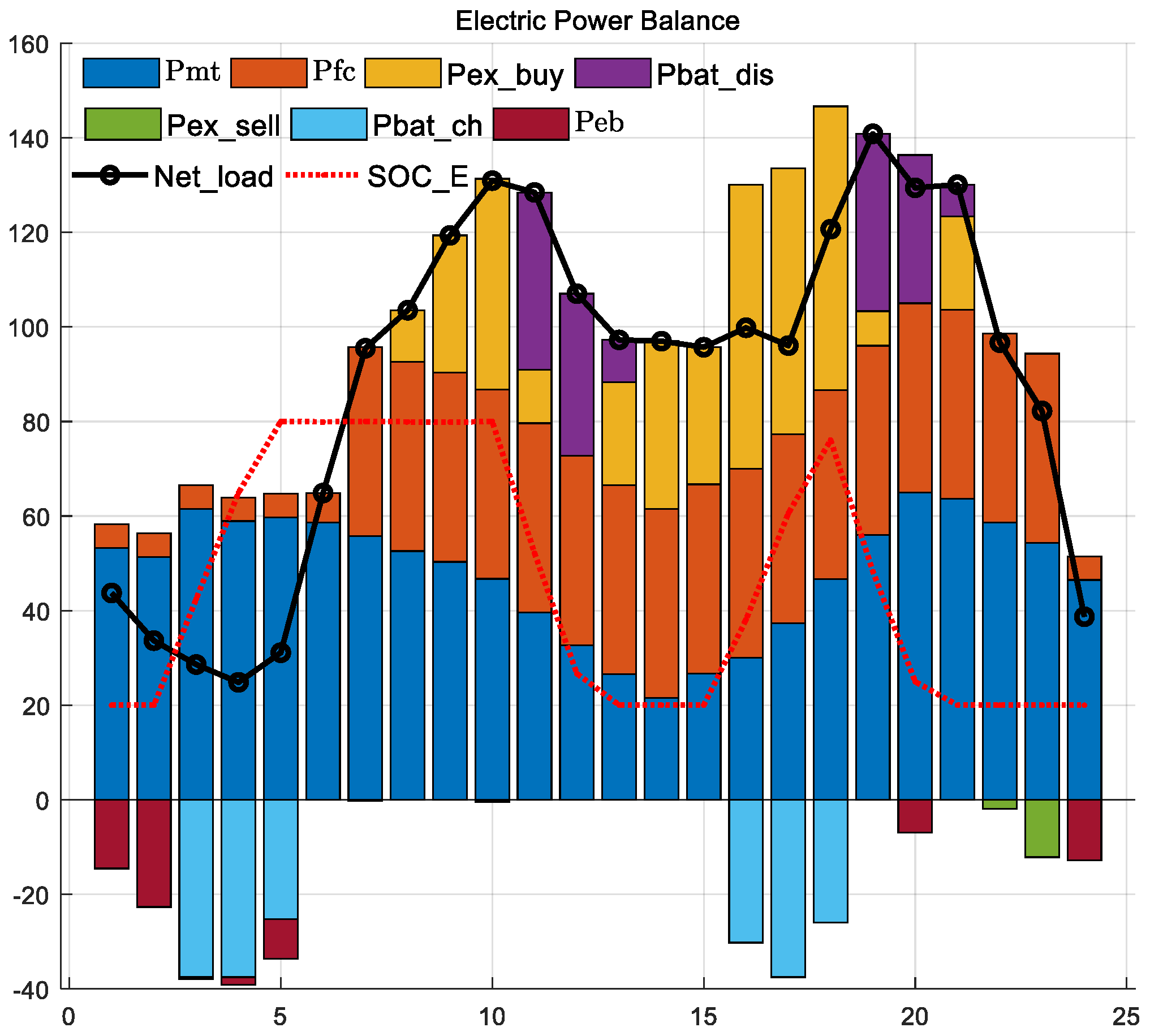
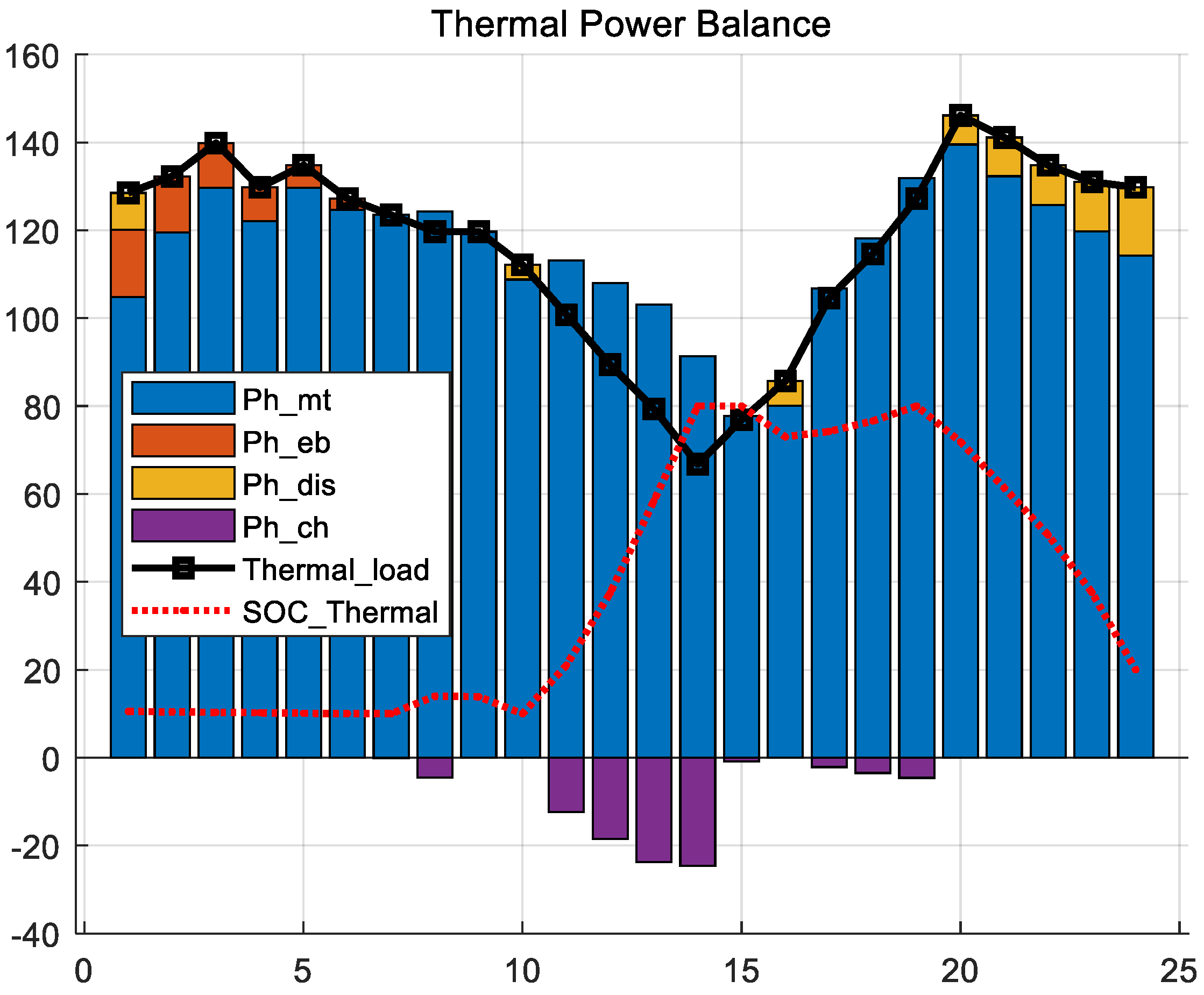
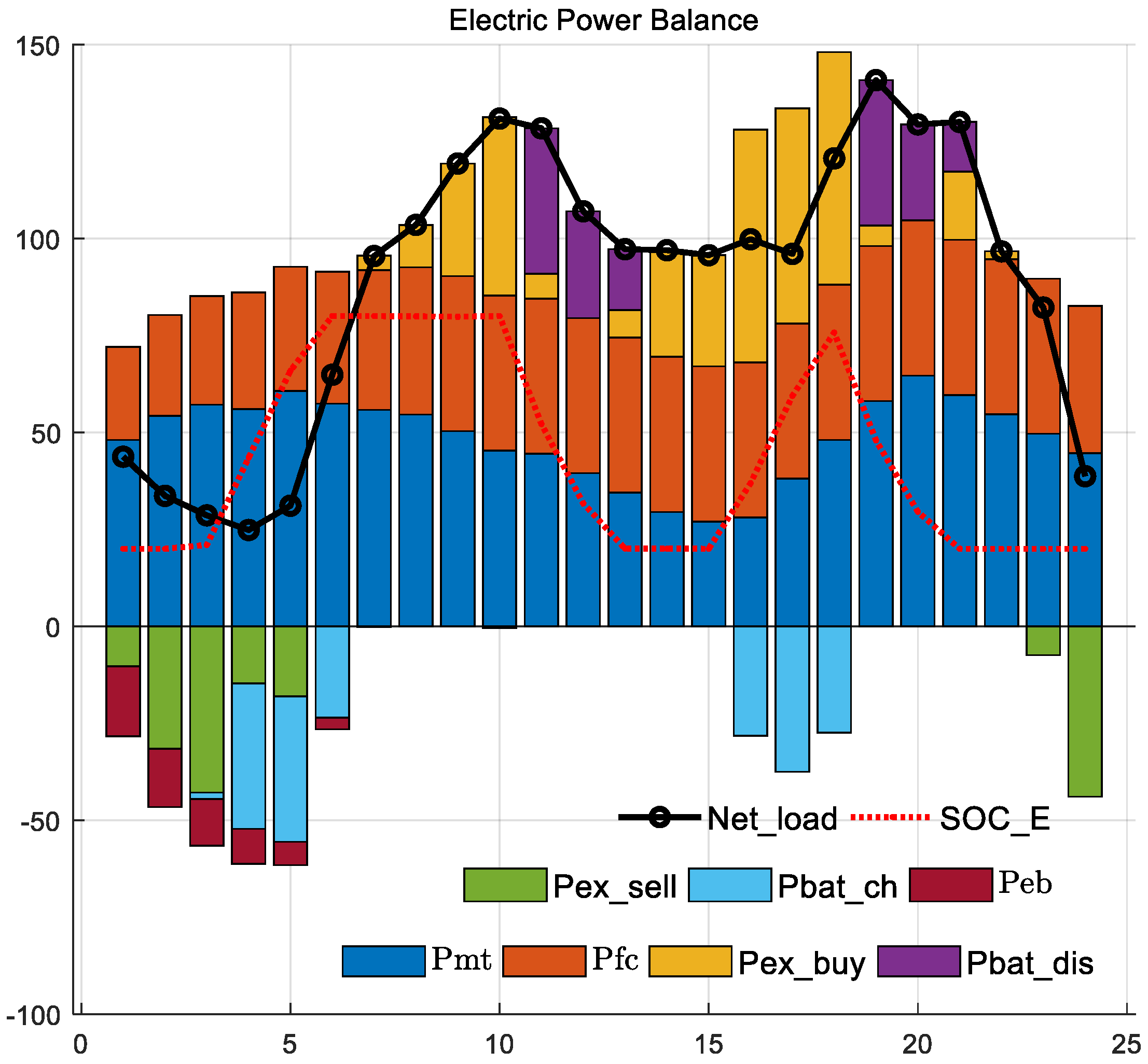
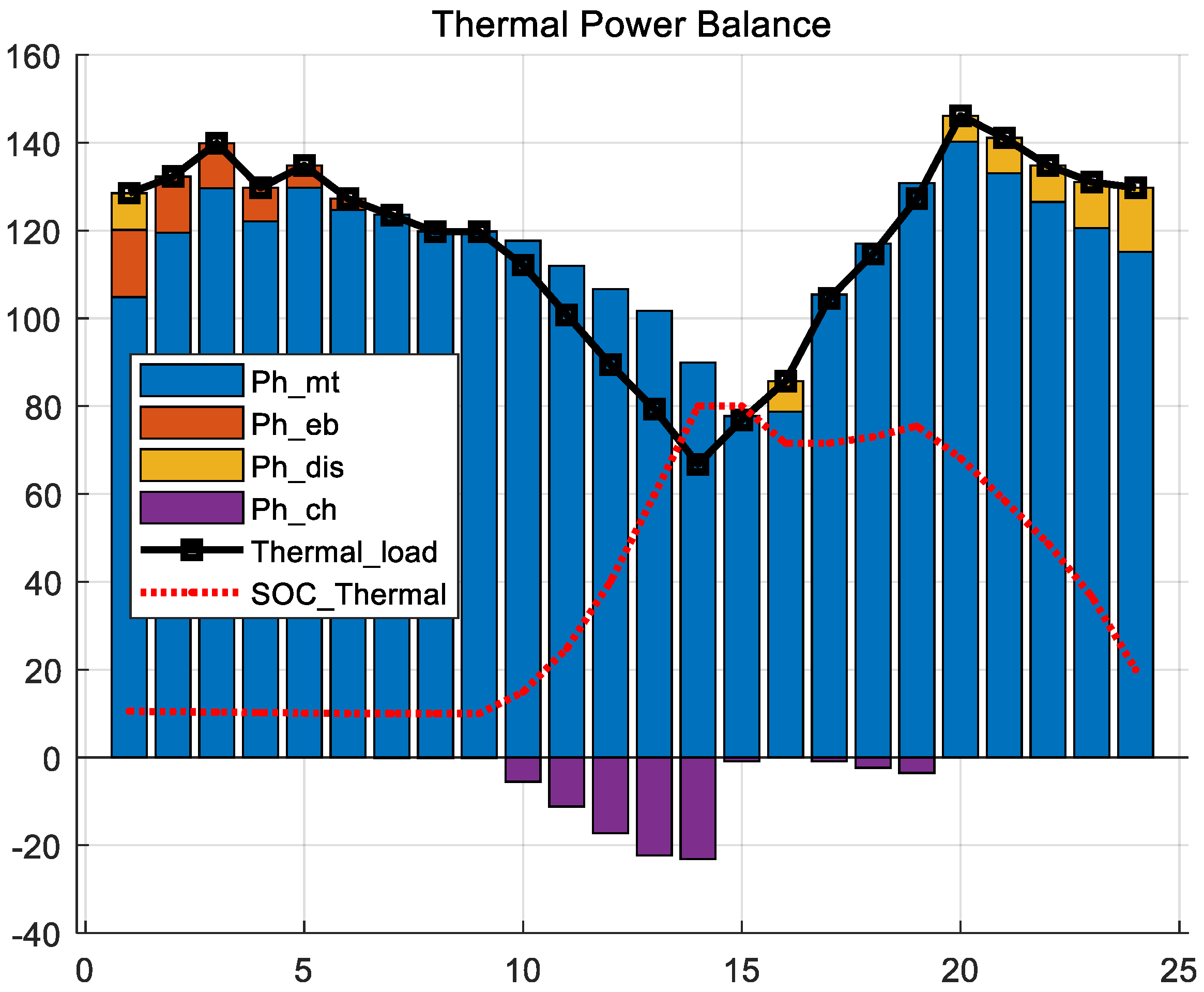
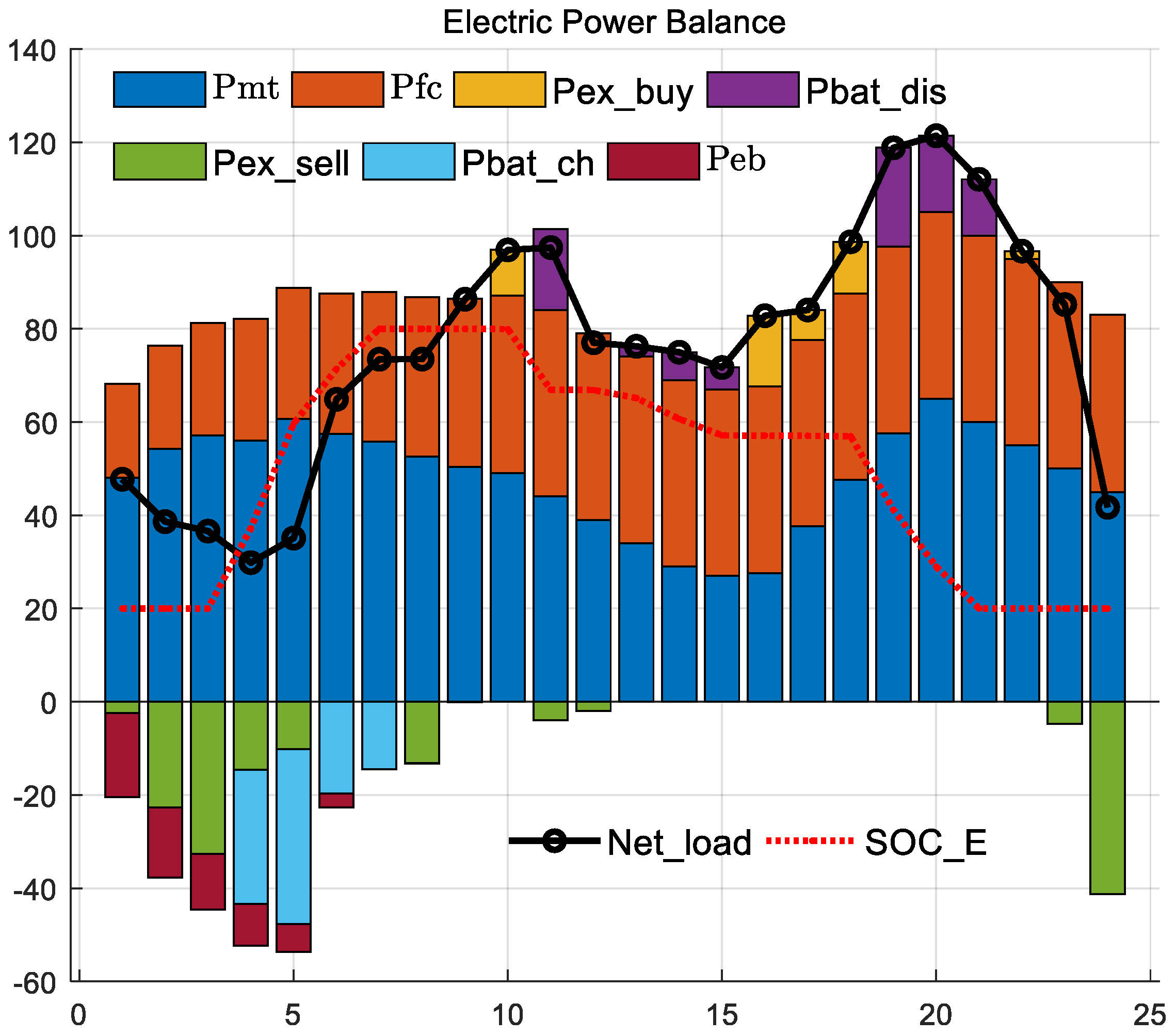
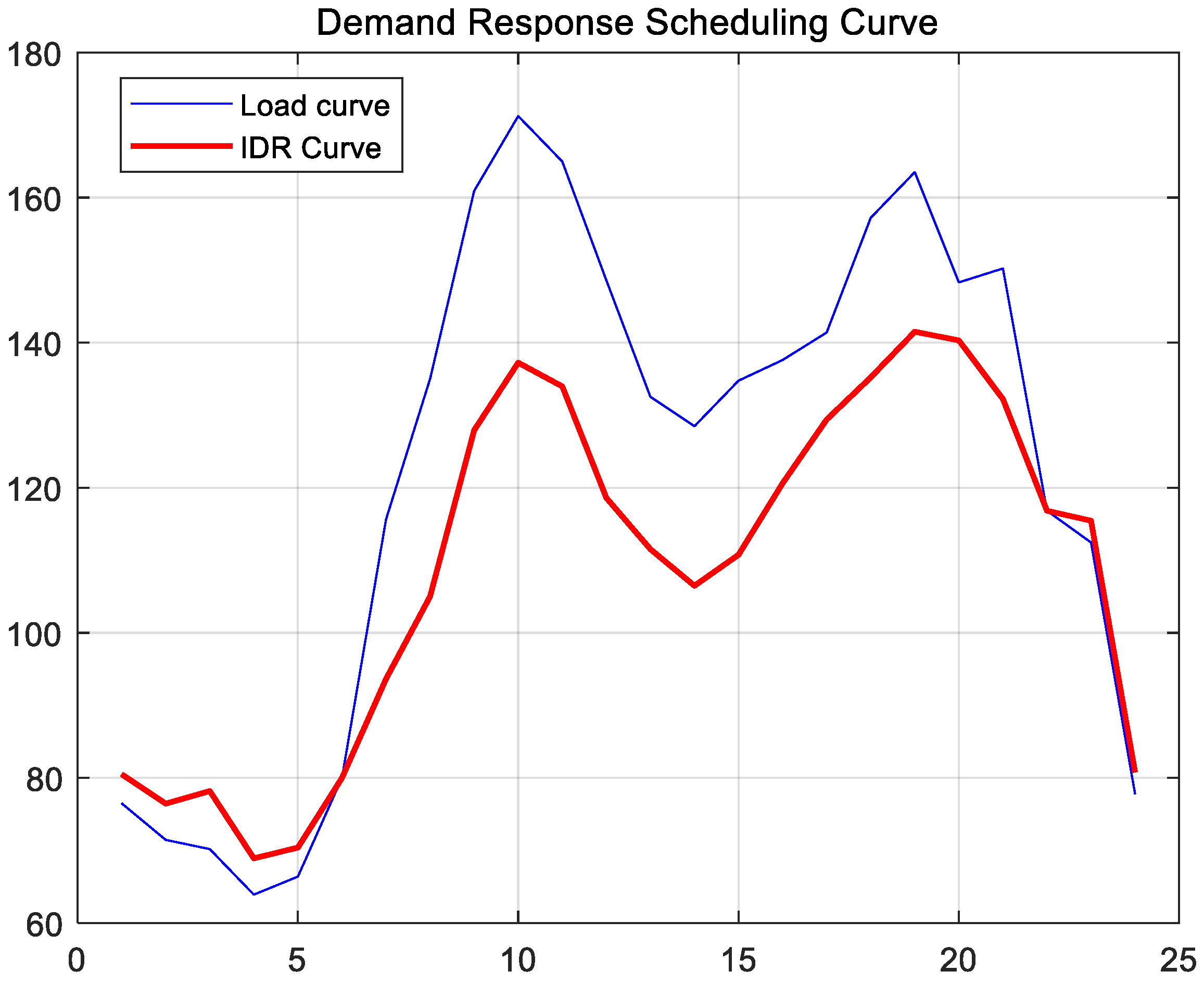
| Type | ||||
|---|---|---|---|---|
| EES | 0.9 | 0.2 | 0.8 | 30 |
| TES | 0.9 | 0.2 | 0.8 | 0 |
| Period | Buy from Grid | Sell to Grid | |
|---|---|---|---|
| Peak | 10:00–15:00 | 1.15 | 0.90 |
| 18:00–21:00 | |||
| Flat | 07:00–10:00 | 0.75 | 0.55 |
| 15:00–18:00 | |||
| 21:00–23:00 | |||
| Valley | 23:00–07:00 | 0.40 | 0.20 |
| Cost | No IDR Scheme | IDR Scheme |
|---|---|---|
| Total cost | 1163.9 | 873.3 |
| Gas cost | 1102.9 | 1090.7 |
| Grid cost | 269.1 | −6.8 |
| Maintenance cost | 71.6 | 70.3 |
| Thermal revenue | 279.5 | 279.5 |
| IDR revenue | ---- | 346.1 |
Disclaimer/Publisher’s Note: The statements, opinions and data contained in all publications are solely those of the individual author(s) and contributor(s) and not of MDPI and/or the editor(s). MDPI and/or the editor(s) disclaim responsibility for any injury to people or property resulting from any ideas, methods, instructions or products referred to in the content. |
© 2023 by the author. Licensee MDPI, Basel, Switzerland. This article is an open access article distributed under the terms and conditions of the Creative Commons Attribution (CC BY) license (https://creativecommons.org/licenses/by/4.0/).
Share and Cite
Wang, L. Optimal Scheduling Strategy for Multi-Energy Microgrid Considering Integrated Demand Response. Energies 2023, 16, 4694. https://doi.org/10.3390/en16124694
Wang L. Optimal Scheduling Strategy for Multi-Energy Microgrid Considering Integrated Demand Response. Energies. 2023; 16(12):4694. https://doi.org/10.3390/en16124694
Chicago/Turabian StyleWang, Long. 2023. "Optimal Scheduling Strategy for Multi-Energy Microgrid Considering Integrated Demand Response" Energies 16, no. 12: 4694. https://doi.org/10.3390/en16124694
APA StyleWang, L. (2023). Optimal Scheduling Strategy for Multi-Energy Microgrid Considering Integrated Demand Response. Energies, 16(12), 4694. https://doi.org/10.3390/en16124694










